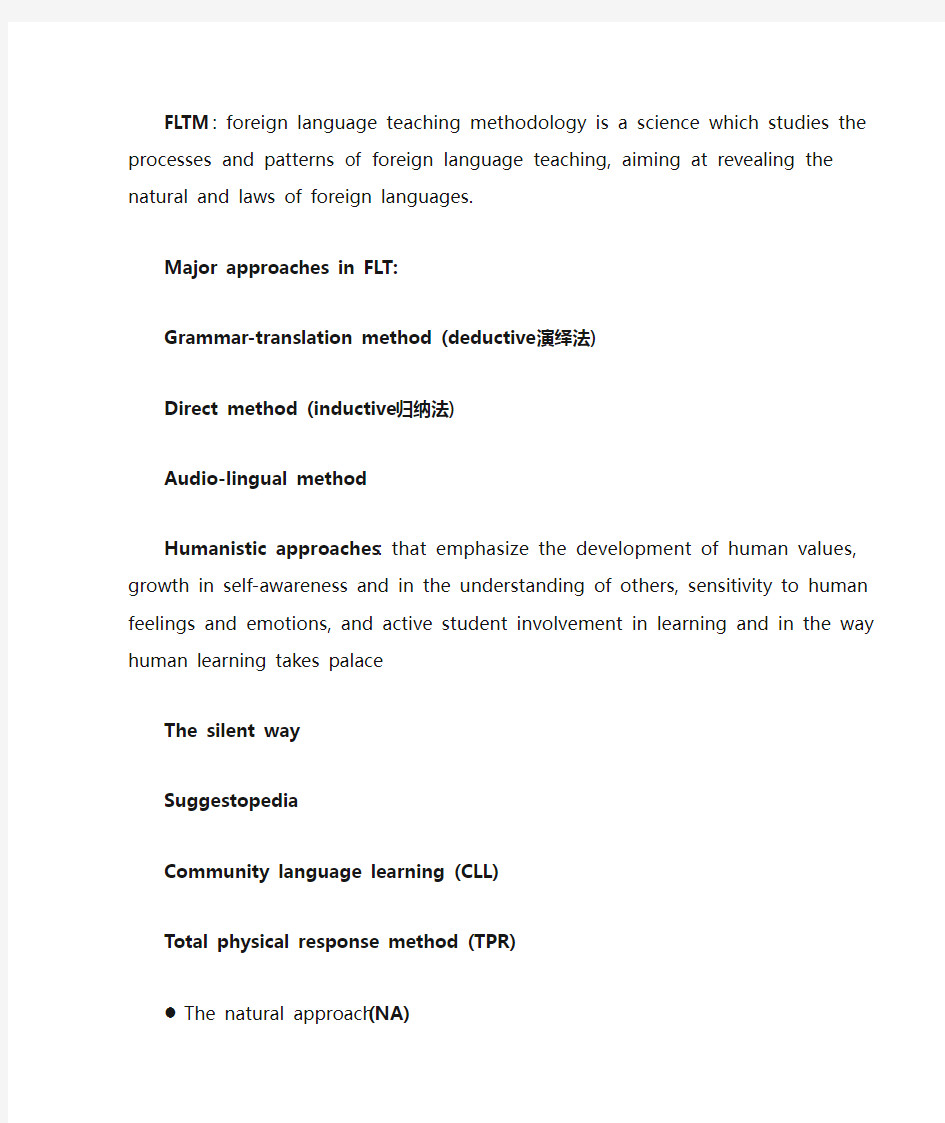《英语教学法教程》知识点总结

- 1、下载文档前请自行甄别文档内容的完整性,平台不提供额外的编辑、内容补充、找答案等附加服务。
- 2、"仅部分预览"的文档,不可在线预览部分如存在完整性等问题,可反馈申请退款(可完整预览的文档不适用该条件!)。
- 3、如文档侵犯您的权益,请联系客服反馈,我们会尽快为您处理(人工客服工作时间:9:00-18:30)。
FLTM: foreign language teaching methodology is a science which studies the processes and patterns of foreign language teaching, aiming at revealing the natural and laws of foreign languages.
Major approaches in FLT:
Grammar-translation method (deductive演绎法)
Direct method (inductive归纳法)
Audio-lingual method
Humanistic approaches: that emphasize the development of human values, growth in self-awareness and in the understanding of others, sensitivity to human feelings and emotions, and active student involvement in learning and in the way human learning takes palace
The silent way
Suggestopedia
Community language learning (CLL)
Total physical response method (TPR)
●The natural approach(NA)
●The communicative approach(CA )
An approach is a set of correlative assumptions dealing with the nature of language teaching ad leaning. Approach is axiomatic. It describes the nature of the subject matter to b taught.
Method is an overall plan for the orderly presentation of language material, no part of which contradicts, and all of which is based upon, the selected approach. An approach is axiomatic, a method is procedural. Within one approach, there can be many methods.
A technique is implementation---that which actually takes place in a classroom. It is a particular trick, stratagem, or contrivance used to accomplish an immediate objective. Techniques must b consistent with a method, and therefore I harmony with an approach as well.
Views on language:
Structural view: the structural view of language sees language as a linguistic system made up of various subsystems: the sound system (phonology); the discrete units of meaning produced by sound combinations (morphology); and the system of combining units of meaning for communication (syntax).
Functional view: the functional view not only sees language as a linguistic system but also means for doing things. Functional activities: offering, suggesting, advising, apologizing, etc.
International view: considers language to be a communicative tool, whose main use is to build up and maintain social relations between people. Therefore, learners not only need to know the grammar and vocabulary of the language but as importantly they need to know the rules for using them in a whole range of communicative contexts.
Process-oriented theories: are concerned with how the mind organizes new information such as habit formation, induction, making inference, hypothesis testing and generalization.
Condition-oriented theories: emphasize the nature of the human and physical context in which language learning takes place, such as the number of students, the kind of input learners receives, and the atmosphere.
Behaviorist theory, the idea of this method is that language is learned by constant repletion and the reinforcement of the teacher. Mistakes were immediately corrected, and correct utterances were immediately praised.
Cognitive theory, language is not a form of behavior, it is an intricate rule-based system and a large part of language acquisition is the learning of this system.
Constructivist theory, believes that learning is a process in which the learner constructs meaning based on his/her own experiences and what he/she already knows.
Socio-constructivist theory, similar to constructivist theory, socio-constructivist theory emphasizes interaction and engagement with the target language in a social context based on the concept of “Zone of Proximal Development” (ZPD) and scaffolding.
Ethic devotion, professional qualities and personal styles
CLT: communicative language teaching
TBLT: task-based language teaching
The goal of CLT is to develop students’ communicative competence, which includes both the knowledge about the language and the knowledge about how to use the language appropriately in communicative situations. P16
Hedge discusses five main components of communicative competence: linguistic competence, pragmatic competence, discourse competence, strategic competence, and fluency.
Howatt proposes a weak and a strong version of CLT.
Weak version: learners first acquire language as a structural system and then learn
